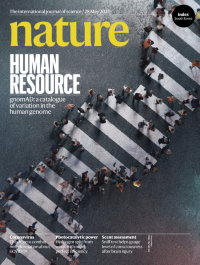Volume 581
-
No. 7809 28 May 2020
Human resourceIn this week’s issue, four papers provide in-depth insights gleaned from the Genome Aggregation Database (gnomAD). A successor to 2016’s ExAC database, which held the exomes of 60,706 individuals, gnomAD aggregates 125,748 exomes and 15,708 whole-genome sequences. This increase in size and scope has allowed the gnomAD Consortium to catalogue not only single nucleotide variants between individuals but also more complex structural variants, made up of 50 or more nucleotides. In the main paper, Konrad Karczewski and colleagues review the database and explore variants that can inactivate protein-coding genes. In a second paper, Beryl Cummings and co-workers show that RNA expression data can be used to guide variant interpretation. In another paper, Eric Minikel and colleagues probe how the gnomAD data might help to identify genetic targets for drugs. And in the fourth paper, Ryan Collins and co-workers set out a catalogue of 433,371 structural variants and analyse them for their influence on physiological traits.
Nature Index
-
No. 7808 21 May 2020
Ancient jewelleryThe cover shows jewellery that dates to between 46,000 and 43,000 years ago. Made from cave bear teeth, these pendants were unearthed during excavations at Bacho Kiro Cave in Bulgaria. In this week’s issue, Jean-Jacques Hublin and his colleagues discuss the artefacts and the human bone fragments that they uncovered in the cave. The finds, which include a human tooth, represent the earliest modern human remains to be found in Europe and, through the jewellery design, provide further evidence of cultural interactions between Homo sapiens spreading west through the continent and local Neanderthals. The authors’ DNA analysis and radiocarbon dating of the human remains suggest that modern humans arrived in the mid-latitudes of Europe before 45,000 years ago.
-
No. 7807 14 May 2020
Line of sightLidar is a key technology for modern robotics and self-driving cars, where it complements camera vision and radar, and acts as an eye in the dark for the vehicles. It uses laser light to illuminate an object, and then works out the object’s distance and velocity by measuring reflected pulses. To be effective, the system needs to block out interference from the Sun and other light sources. This can be done using coherent detection, in which the reflected light is mixed with transmitted light and the frequency of the reflected light is analysed, providing a direct way to detect the relative velocity of an object via the Doppler effect. But this approach has proved hard to scale up. In this week’s issue, Tobias Kippenberg and his colleagues present a lidar architecture based on a soliton microcomb that uses a photonic chip. The light source emits a wide spectrum of sharp lines with equally spaced and simultaneously chirped frequencies, which allows the system to obtain parallel measurements across 30 separate channels. The researchers suggest that soliton microcombs could be the basis for a compact, massively parallel, ultrahigh-frame-rate coherent lidar.
Nature Outlook
-
No. 7806 7 May 2020
A trick of the tailThe cover shows an artist’s impression of the giant theropod Spinosaurus aegyptiacus. Like other non-avian dinosaurs, spinosaurs are usually thought of as largely land-dwelling, but it has been suggested that some of them may have been semi-aquatic — an idea that has proved controversial. In this week’s issue, Nizar Ibrahim and his colleagues present a Spinosaurus fossil with a uniquely shaped tail that seems to be adapted for propulsion in water. The remains were found in the 97-million-year-old Kem Kem beds of southeastern Morocco and represent the most complete skeleton of a Cretaceous theropod found in mainland Africa to date. The flexible tail has very tall neural spines and would have been capable of extensive left-to-right movement. Modelling studies by the researchers suggest that the tail would have created significant thrust, indicating that Spinosaurus could have moved through water in a similar manner to modern crocodiles.




